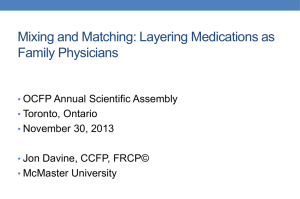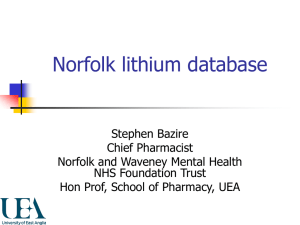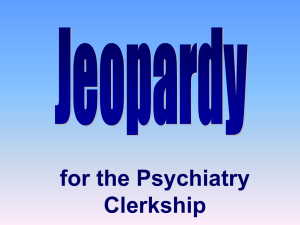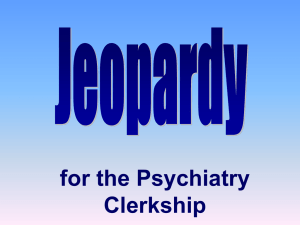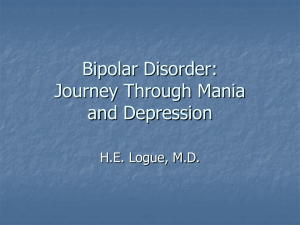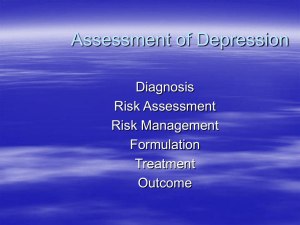BIPOLAR DISORDER
advertisement
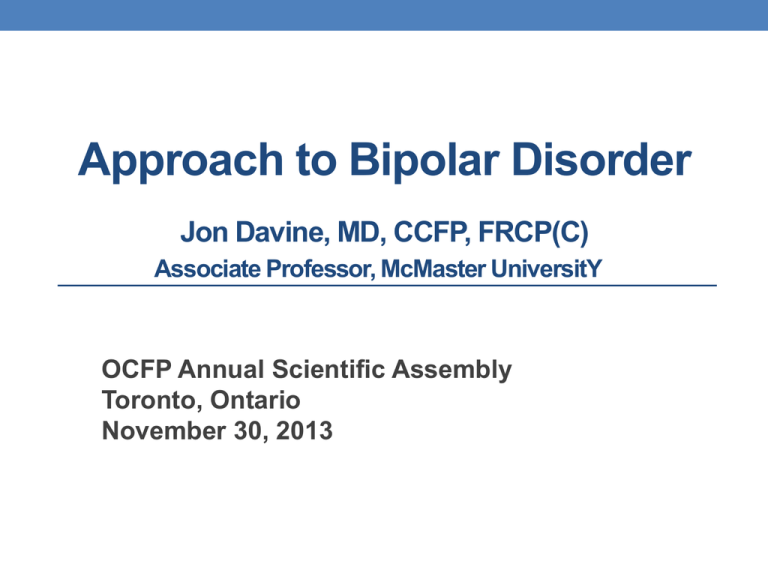
Approach to Bipolar Disorder Jon Davine, MD, CCFP, FRCP(C) Associate Professor, McMaster UniversitY OCFP Annual Scientific Assembly Toronto, Ontario November 30, 2013 Faculty/Presenter Disclosure • Faculty: Jon Davine • Program: 51st Annual Scientific Assembly • Relationships with commercial interests: Lundbeck, Canada: Educational presentations Advisory Board member Disclosure of Commercial Support • This program has received NO financial support • This program has received NO in-kind support • Potential for conflict(s) of interest: – NONE Mitigating Potential Bias • I am not discussing any of Lundbeck Canada’s drugs in this presentation • When discussing pharmacotherapy, I will be using CANMAT guidelines Objectives • Learn how to make the diagnosis of bipolar in a time efficient manner • Learn how to use psychopharmacology to treat Bipolar Disorder, using current guidelines • Learn about issues of psychopharmacology and pregnancy Bipolar Disorder • MANIC • • • • • 7 days or more, unless hospitalized Interferes with life greatly Increased mood Increased energy Decreased sleep • HYPOMANIC • 4 days or more • Somewhat interferes with life, seen by others as uncharacteristic • Same features as manic, no marked impairment in functioning • IMPORTANT: Separate Bipolar II from Axis II, cluster B mood lability • Remember time line, days vs. hours or a day • Out of the blue vs. response to stressors Bipolar I vs. Bipolar II • Bipolar I • Manic phase(s) +/- depression phase(s) • 1% lifetime prevalence • Bipolar II • Hypomanic phase(s) + depression phase(s) • 1.1% lifetime prevalence Bipolar Disorder • Mean age of onset - early to mid 20's • Peak age is 15-19 • Usually 3-10 year lag between onset and treatment • Initially • Depression in women • Mania in men • Twin studies and first degree relative studies support the fact of heritability Bipolar Terms • Bipolar • Manic phase • Hypomanic phase • Depressed • Mixed phase - depression and mania essentially coexist, switching over hours, or every 1 - 2 days. Also has been called ultra rapid cycling. Must last at least one week. Causes marked impairment in functioning. • Rapid Cycling • 4 or more episodes/year • Going from manic to depressed - counts as two episodes THINGS TO DO: • Assess for organicity • Harm to others (e.g., driving) • EtOH/Substance abuse • High co-morbidity rate • Can worsen • Suicidality • 17-19% lifetime prevalence of completed suicide • More often in depressed state • Educate • Inadequately treated patient may have 10 or more episodes • Intervals between episodes narrows as person ages • Sleep deprivation can provoke hypomanic/mania Levels of Evidence • Level 1 • Meta-analysis or replicated RCT with placebo • Level 2 • At least one RCT with placebo or active comparison condition • Level 3 • Uncontrolled trial with 10 or more subjects • Level 4 • Anecdotal reports or expert opinion Treatment Recommendations • 1st line (A) • Level 1 or 2 evidence plus clinical support for efficacy and safety • 2nd line (B) • Level 3 evidence or higher plus clinical support for efficacy and safety • 3rd line (C) • Level 4 evidence or higher plus clinical support for efficacy and safety • Not Recommended • Level 1 or 2 evidence for lack of efficacy Lithium – Indications • Anti-manic • 78% response rate • Level I evidence • Anti-depressant • 79% response rate • Level I evidence • Prophylaxis • 6 fold decrease in subsequent episodes • Level I evidence Lithium – Pharmacology • Half-life = 14-30 hours • Not metabolized • Cleared by kidney (mind renal function) • Not protein bound Lithium – Side Effects • Polyuria, polydipsia (Diabetes Insipidus) • Treat with diuretics if necessary • * Increase weight • Cognitive problems • * Tremor • Treat with Beta-Blockers • Sedation • * GI distress • Increase WBC • ECG changes • Usually benign • Rarely conduction abnormality Lithium – Other Effects • Hypothyroid (5-35%) • More females after 6-18 month treatment • Generally reversible • Can replace with thyroxine • Nephrotoxicity • Controversy, but appears to be Lithium – Levels and Side Effects • 0.4-0.6 mmol/L • Decreased side effects • Increased risk of episodes • 0.6-0.8 mmol/L • Most often chosen • Not well studied • 0.8-1.1 mmol/L • Deceased risk of episodes • Increased side effects • Balance must be chosen between efficacy and side effects Lithium – Overdose • >1.5 mmol/L = Toxic • coarse tremor • Vomiting • Blurred vision • Vertigo • Confusion • Increased DTR • > 2.5 mmol/L = Life threatening • Treatment: hemodialysis Lithium – What to do before starting: • Workup – repeat every 6-12 months • ECG • CBC • TSH • Creatinine, ‘lytes, u/a • Pregnancy test if applicable • Blood lithium levels • 5 days after starting, and then 5-7 days after dosage changes • Get 2 therapeutic serum levels, then repeat q3months. Lithium - Dosage • Start at 300 mg PO BID • Increase by 300 mg/day depending on levels • Usual dosage 900-1500 mg/day • Measure "trough" levels • Patient to have blood test 12 hours post last dose Valproic Acid – Indications • Manic – 56% response rate (near Lithium effectiveness) • Level I evidence (A for mania and mixed states) • Bipolar Depression – Few studies for bipolar depression • Level III evidence (B) • Prophylaxis • Level II evidence (A) Valproic acid - Pharmacology • 2 forms • Valproate and Divalproex sodium • Divalproex sodium (Epival) has less GI side effects, and is therefore preferred • Half-life = 6-16 hours • Metabolized by liver • Protein bound Valproic Acid – Side Effects • * GI distress (use divalproex sodium) • Sedation • * Benign increased ALT, increased AST • Tremor • Hepatotoxicity • Decreased platelets, WBC • *Increased appetite, weight • Agranulocytosis • Polycystic ovarian disease – contraindicated Valproic Acid – When you start: • Workup before starting • History And Physical • LFT'S • CBC with platelets • Do initially, then at 4 weeks, repeat q 3-6 months • Starting Dose 250 mg BID • Increase by 250 mg Increments weekly • + teratogenic • Levels • 350-700 μmol/L3 Lamotrigine • Especially helpful from down-up • More effective in preventing depression • Less weight gain • Watch for any rash • (5-10%) Stevens-Johnson syndrome a possibility, (1/5000), thus D/C. • Start at 12.5-25 mg PO OD • Increase by 12.5-25 mg PO q1-2weekly • Levels – Usually 50-200 mg/day • No blood level monitoring necessary Lamotrigine – Indications • Mania • Level III evidence (D) • Depression • Level I evidence (A) • Prophylaxis • Level I evidence (A) Carbamazepine - Indications • Mania • Level I evidence, but (C) due to s/e, drug interactions • Bipolar depression • Level II evidence (C) • Prophylaxis • Level II evidence (C) Carbamazepine - Pharmacology • Half-life is ultimately 5-26 hours • Metabolized by the liver • Protein bound • Carbamazepine induces the CYP 450 enzyme system, resulting in: • Decreased neuroleptic level • Decreased benzodiazepines • Decreased TCA • Decreased anti-convulsants • Auto-induction Carbamazepine – Side Effects • Diplopia • Blurred vision • Fatigue, drowsiness • Ataxia, dizziness • Nausea, vomiting • Less common • Rashes • Decreased WBC • Decreased platelets • Increased LFTs • Hyponatremia Carbamazepine – Adverse Reactions • Idiosyncratic, rare: • Agranulocytosis • Aplastic anemia • Hepatic failure • Exfoliative dermatitis (Stevens-Johnson Syndrome) • Pancreatitis • Toxicity symptoms: • Dizziness • Ataxia • Sedation • Diplopia • Stupor, coma, decreased LOC, convulsions Carbamazepine - Starting • Workup before starting • History and Physical • CBC with diff, platelets • LFT's • Start at 100 mg BID • Increase by 200 mg q5d with levels • 800-1000 mg/day • Range: 200-1800 mg Carbamazepine – Follow up • Therapeutic levels not established • We use same as for seizure • 17-42 μmol/L • Labwork • CBC, platelets q2weeks for first 2 months • LFT's • Then q3months along with carbamazepine levels Olanzapine • Has been HPB approved as anti-manic, but also as monotherapy in bipolar • I would not go this route due to effects of increased weight, increased glucose, triglycerides, and lipids • Olanzapine and clozapine have more weight gain than risperidone and quetiapine • Possible link to diabetes type 2 Olanzapine – Indications • Mania • Level I evidence (A) • Depression • Level I evidence (B) • Prophylaxis • Level I evidence (A) Gabapentin, Topiramate • For mania, depression, and prophylaxis: • Level III (D) • Not recommended or prescribed Acute Treatment of Mania • Acute treatment duration = 2 to 10 weeks • Rule out organic • Cushing's • Thyroid • MS • Steroids • *antidepressants - controversy • Substance abuse Acute Treatment of Mania, Mixed State, Rapid Cycling • History and physical • Labwork • CBC with diff • Lytes, creatinine • LFT's • TSH • EKG (if >40) • U/A • Pregnancy test if relevant CANMMAT (09):1st Line Treatments for Mania • Monotherapy: Lithium, divalproex, Risperidone, Olanzapine, Quetiapine, Ziprasidone, Aripiprazole • Combination: Lithium or divalproex plus Atypicals, except Ziprasidone (increases response by 20%) • Rapid Cycling/Mixed: Divalproex • **Discontinue antidepressant, stimulant meds Atypical Neuroleptics • Risperidone, Olanzapine, and Quetiapine are all approved • • • • • • for use as anti manic agents Risperidone--1-4 mg/day Olanzapine 5-20 mg/day Quetiapine 200-800 mg/day Aripiprazole 10 -15 mg/day Ziprasidone 20-80 mg BID Anti-manic, anti-psychotic Bipolar Depression • 20% of Bipolar Depressive Episodes run a chronic course • Mild depressive symptomatology may be successfully treated with CBT or IPT • Lithium • Response rates from 64% to 100%. Level I (A) evidence • Antidepressants • Level I (B) evidence. • Watch for flips (more common with tricyclics) • Use with concomitant mood stabilizer to avoid flips Lamotrigine in Bipolar Depression • Lamotrigine • Sometimes added to lithium as mood stabilizer • It works better from the “bottom up” • Lithium and Epival work better from the “top down” Atypical Neuroleptics in Bipolar Depression • Atypical Neuroleptics can be used as acute antidepressants • Olanzapine has level 1 evidence as monotherapy for acute depression • Quetiapine now approved for bipolar depression CANMMAT (09):1st Line Treatments for Bipolar Depression • Monotherapy: • Lithium, lamotrigine, quetiapine • Combination Therapy: • Lithium and divalproate • Lithium or divalproate plus SSRI or buproprion • Olanzapine and SSRI Continuation Phase of Treatment • Usually lasts 6-12 weeks • Continue with psychoeducation/counseling • Develop relationship • Helps compliance • Deal with stressors Drugs in Continuation Phase • If Benzos were used, try to wean off • No evidence for them as prophylactic agents • If Atypical Neuroleptics were used, gradually wean and discontinue unless: • (1) persistent psychosis, or (2) adjunctive prophylaxis • If antidepressants used, once depression has past, if asymptomatic for 6-12 weeks, gradually wean off over several weeks. Maintenance/Prophylactic Phase • Risk of recurrence? not sure, but: • Mood stabilizers help with moderate-severe illness • But there is a subgroup of patients with mild illness who may not need prophylaxis • Hard to identify this group • Indefinite maintenance pharmacotherapy has been supported by “decision analysis”, which analyzes: • “costs”(e.g., lithium exposure) • “benefits”- (i.e., decreased risk of relapse) CANMMAT (09):1st Line Treatments for Maintenance • Monotherapy: • Lithium, divalproate, lamotrigine, risperidone LA, olanzapine, quetiapine, aripiprazole • Combination: • Lithium or divalproate plus risperidone LA, quetiapine, or ziprasidone CANMMAT (09):1st Line Treatments for Bipolar II • Depression: Quetiapine • Level 1 evidence • Maintenance: Lithium, Lamotrigine • Level 2 evidence Therapy in Pregnancy • All mood stabilizers are teratogenic • Risk vs. benefit • Lithium lower risk (Ebstein's anomaly, 0.1%) • Tricuspid valve displacement • If illness not that severe, consider planned pregnancy without meds • 4 week medication-free period pre-conception • ECT, SSRI, Neuroleptics all lower risk in 1st trimester Epival in Pregnancy • Epival (sodium valproate) much more problematic • Neural tube defects may increase to 5% • Try to avoid in women of child bearing age, especially weeks 1-10. • Can use folic acid 5 mg. PO OD • Can do serial ultrasounds examining the neural tube Lamotrigine in Pregnancy • Cleft lip and palate • Possible less teratogenic Dosage in Pregnancy • May need to increase dose • Especially lithium during this time • Then decrease dose after delivery (re: GFR) • Post partum has >50% risk of an episode • Recommend re-start therapy after delivery • All secreted through breast milk • Data suggests no immediate risk • No data regarding later behavioural effects • Speak to Motherisk or Womens Health Concerns about concerns surrounding breastfeeding Disability Issues • Stable bipolar is not disabling • Most people should hit their normal “life arc”, including working • Let patients know this! • A minority of treatment resistant cases may require disability MDQ: Mood Disorders Questionnaire • Self report for bipolar • 5 questions • 13 items on question 1
